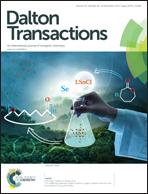The first scorpionate ligand based on diazaphosphole†
Abstract
The reaction of PhBCl2 with 1H-1,2,4-λ3-diazaphosphole in the presence of NEt3 gives a new scorpionate ligand, phenyl-tris(1,2,4-diazaphospholyl)borate (PhTdap). The coordination behaviour of this ligand toward transition and non-transition metals has been comprehensively studied. In the thallium(I) complex, Tl(PhTdap), κ2-N,N bonding supported with intramolecular η3-phenyl coordination has been observed in the solid state. Tl(PhTdap) also shows unusual intermolecular π-interactions between five-membered diazaphosphole rings and the thallium atom giving infinite molecular chains in the crystal. In the square planar complex [Pd(C,N-C6H4CH2NMe2)(PhTdap)], κ2-bonded scorpionate has been detected in both solution and in the solid state. For other studied compounds with the central metal ion Ti(IV), Mo(II), Mn(I), Fe(II), Ru(II), Co(II), Co(III), Ni(II) and Cd(II), the κ3-N,N,N coordination pattern was observed. Electronic properties of PhTdap and its ligand-field strength were elucidated from UV-Vis spectra of transition-metal species. The CH/P replacement on going from tris(pyrazolyl)borate to the ligand PhTdap causes a slight increase in electronic density rendered to the central metal atom. The following order of ligand-field strength has been established: HB(3,5-Me2pz)3 < PhB(pz)3 < HB(1,2,4-triazolyl) < HB(pz)3 < PhB(1,2,4-triazolyl) < PhTdap. The crystal structures of ten metal complexes bearing the new ligand are reported. The possibility of PhTdap coordination through the phosphorus atom is also briefly discussed.


 Please wait while we load your content...
Please wait while we load your content...